The History of Plastic Surgery
PLASTIC SURGERY
Modern Plastic Surgery is celebrating its 100th birthday this year, but a lot has changed since it was first used by Harold Gillies on wounded soldiers during World War One. We explore how some of the treatments we know today first appeared and how our perception of cosmetic treatments has altered over the last century.
First things first – it’s important to note the word ‘modern’ plastic surgery. Treatments like blepharoplasty and rhinoplasty are thought to have first been performed as early as 600BC – albeit not as we know them. It was a common occurrence to have one’s nose or upper lips ‘regrafted’ using skin from elsewhere on the body, a tradition that continued until it was coined as “plastic surgery” (from the Greek plastikos – to be moulded) in the 1830s. Gillies, however, completely changed the face of the treatment in 1915 and began the roots of what we now know as plastic surgery treatments.
The injuries sustained by soldiers during WW1 battles were too severe to be treated using skin grafts. What Gillies created, instead, was something called the tube pedicle – a technique which involved cutting a strip of flesh from an unaffected area of the body, leaving one end attached, and rolling it into a tube before swinging it round to where the wound or disfigurement was. Antibiotics had not yet been invented, which is why whole grafts of flesh couldn’t simply be taken from elsewhere; using a tube not only kept the original blood supply intact, but also lessened this huge risk of infection, making it an amazing step forward in reconstructive surgery.
The advancement in possibilities was incredible, and Gillies’ techniques were further developed by his cousin and pupil Archibald McIndoe during the Second World War. This led to the practice becoming more wide spread outside the battlefield and, with no standard criteria for doctors to refer to themselves as plastic surgeons, ill-experienced practitioners began performing treatments which led to scarring, amputation, disfigurement and even death. It was from this that the first regulatory body for plastic surgery, the American Board of Plastic and Reconstructive Surgery (ASPRS), was formed. The aesthetic medical form then began to grow in its own right and the procedures we know today began to appear, with the first breast augmentation taking place in 1962 and screen icons like Marilyn Monroe and Rita Hayworth undergoing various forms of plastic surgery treatments.
Last year 20 million plastic surgery procedures were undertaken around the world, as well as many more non-surgical options. Modern developments have seen procedures become less-invasive and with far less risk, with many surgical treatments even performed under local anaesthetic (with sedation). Procedures like Vaser Lipo are revolutionary walk-in walk-out options, and even Facelifts and Rhinoplasty now have non-surgical alternatives as well as various different forms. 100 years on, ours is a very different world to Gillies’. The plastic surgery we know and recognise is a far cry from the pioneering technique the surgeon developed, and its popularity shows no signs of disappearing. There’s a host of treatments, both surgical and non-surgical, available for patients today. But there’s one thing that has remained the same – the importance of working with a highly recognised, specialist medical team. Regardless of what treatment you undergo or how simple it might seem, you’re only ever as safe as your surgeon.
To find out more about the treatments we offer at The Private Clinic, please call 0333 920 2471 or use our online contact form to request a call back.





